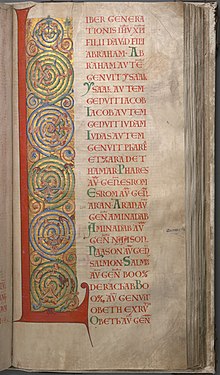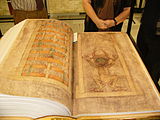Codex Gigas

The Codex Gigas ("Giant Book"; Czech: Obří kniha) is the largest extant medieval illuminated manuscript in the world, at a length of 92 cm (36 in).[1] Very large illuminated bibles were typical of Romanesque monastic book production,[2] but even among these, the page-size of the Codex Gigas is exceptional. The manuscript is also known as the Devil's Bible due to its highly unusual full-page portrait of Satan, and the legend surrounding the book's creation.
The manuscript was created in the early 13th century in the
Eventually finding its way to the imperial library of
Description

The codex's bookbinding is wooden boards covered in leather, with ornate metal guards and fittings. At 92 cm (36 in) long, 50 cm (20 in) wide and 22 cm (8.7 in) thick, it is the largest known medieval manuscript.[6] Weighing 74.8 kg (165 lb), Codex Gigas is composed of 310 leaves of vellum claimed to be made from the skins of 160 donkeys, or perhaps calfskin, covering 142.6 m2 (1,535 sq ft) in total.[7] The manuscript includes illuminations in red, blue, yellow, green, and gold. Capital letters at the start of books of the bible and the chronicle are elaborately illuminated in several colours, sometimes taking up most of the page; 57 of these survive. The start of the Book of Genesis is missing. There are also 20 initials with the letters in blue, with vine decoration in red. There are also two images representing Heaven and Earth during the Creation, as blue and green circles with respectively the sun, moon, and some stars, and a planet all of sea with no landmasses. Within books, major capitals are much enlarged, taking up the height of about five to six lines of text, in red ink, and placed in the margins. Less important divisions, such as the start of verses, are slightly enlarged within the text and highlighted with yellowish ink around the letter forms.[8]
The codex has a unified look as the nature of the writing is unchanged throughout, showing no signs of age, disease, or mold on the part of the scribe.[9] This may have led to the belief that the whole book was written in a very short time (see § Legend), but scientists are starting to investigate the theory that it took over 20 years to complete.[10]
The extraordinary length, size, and detail of the codex have given rise to the legend that it was written by one scribe in one night with help from the Devil himself.[11][12] It initially contained 320 sheets, though twelve of these were subsequently removed.[13] It is unknown who removed the pages or for what purpose.
Illustration of the Devil
He has a large, dark green head, and his hair forms a skull cap of dense curls. The eyes are small, with red pupils, and his red-tipped ears are large. His open mouth reveals his small white teeth, and two long red tongues protrude from the corners of his mouth. The double tongue evokes the forked tongue of a serpent, one of the forms of Satan in Christian iconography. The expression 'forked tongues' is an ancient biblical metaphor (Nordenfalk 1975, n. 15).
Several pages before this double spread are written in yellow characters on a blackened parchment and have a very gloomy character, somewhat different from the rest of the codex. The reason for the discoloration is that these vellum pages have been exposed to the light as readers over the centuries turned the pages toward the infamous illustration.
History

According to legend, the codex was created by
At the end of the
On 7 May 1697, a fire at the Tre Kronor royal castle in Stockholm destroyed much of the Royal Library. The Codex Gigas was thrown out a window; according to the vicar Johann Erichsons, it landed on and injured a bystander.[18]
A National Geographic documentary included interviews with manuscript experts who argued that certain evidence (handwriting analysis and a credit to Hermann Inclusus – "Herman the Recluse") indicates the manuscript was the work of a single scribe.[19]
Content
The first page has two Hebrew alphabets. There are also added slips with
The two works of Josephus then continue the history of the Jews (f. 118–178). The first page of Josephus, which recounts the Genesis creation story, is illustrated in the margin with pictures of Heaven and Earth (f. 118v). These works are followed by
Apart from the alphabets at the start, the entire book is in Latin.[20]
Legend
According to one version of a legend already recorded in the Middle Ages, the scribe was a monk who broke his monastic vows and was sentenced to be walled up alive. To escape death, he promised to create, in one night, a book to glorify the monastery forever, including all human knowledge. Near midnight, he became so desperate that he prayed to Lucifer to help him finish the book in exchange for his soul. The Devil completed the manuscript, and the monk added the Devil's picture as a tribute.[1][21][22] In tests to recreate the work, it is estimated that reproducing only the calligraphy, without the illustrations or embellishments, would have taken twenty years of non-stop writing.[10]
-
Initial with a squirrel
-
F1v, showing Hebrew, Greek, Latin, Glagolitic, and Old Cyrillic alphabets
-
End ofauthor portrait
-
F118v, start of Josephus, Heaven and Earth
-
Blue and red capital in Isidore
-
Viewing a facsimile in the Czech Republic
See also
- List of New Testament Latin manuscripts
- List of Glagolitic manuscripts
References
- ^ a b "Codex Gigas". The National Library of Sweden. Archived from the original on 12 October 2007. Retrieved 13 February 2016.
- ISBN 0801414466
- ^ "About the Content". National Library of Sweden.
- ^ "Medical contents". National Library of Sweden.
- ^ "The Treasury Room – Codex Gigas exhibition". National Library of Sweden.
- ^ Boldan et al. 2007, p. 15.
- ^ "Description of the MS". National Library of Sweden. 19 June 2007. Retrieved 19 November 2013.
- ^ "Decoration". National Library of Sweden.
- ^ "The Treasury Room – Codex Gigas exhibition". National Library of Sweden.
- ^ a b "Devil's Bible". Archived from the original on 3 September 2011.
- ^ Gullick, M. (2007). "The Codex Gigas. A revised version of the George Svensson lecture delivered at the National Library of Sweden, Stockholm, November 2006". Biblis 28: 5–19.
- ^ Braun, David Maxwell. "Devil's Bible Darkest Secrets Explained – National Geographic Society (blogs)". voices.nationalgeographic.org. Archived from the original on 8 October 2017. Retrieved 7 October 2017.
- ^ Boldan et al. 2007, p. 17.
- ^ "Devil's Bible – World Digital Library". WDL.org. Retrieved 15 January 2016.
- ^ Kungliga Bibliothek website. https://www.kb.se/in-english/the-codex-gigas.html
- ISBN 9781925427332pp351-352
- ^ Metzger, Bruce M.; Ehrman, Bart D. (2005). The Text of the New Testament: Its Transmission, Corruption and Restoration. New York; Oxford: Oxford University Press. p. 103.
- ^ "The Stockholm Castle fire of 1697". National Library of Sweden. 19 June 2007. Retrieved 19 November 2013.
- ^ "Mysteries of the Bible Episode Guide". Archived from the original on 10 February 2011.
- ^ a b c "Catalogue Description". National Library of Sweden.
- ^ "Legends". National Library of Sweden. 19 June 2007. Retrieved 19 November 2013.
- ^ Rajandran, Sezin (12 September 2007). "Satanic inspiration". The Prague Post. Archived from the original on 14 December 2013. Retrieved 10 December 2013.
Bibliography
- Boldan, Kamil; Dragoun, Michal; Foltýn, Duan; Marek, Jindřich; Uhlíř, Zdeněk (2007). The Devil's Bible – Codex Gigas: The Secrets of the World's Largest Book. NKP. ISBN 978-80-7050-532-8.
Further reading
- Bártl, S., Kostelecký, J.: Ďáblova bible. Tajemství největší knihy světa, Paseka, 1993. ISBN 80-85192-64-0
- J. Belsheim, Die Apostelgeschichte und die Offenbarung Johannis in einer alten lateinischen Übersetzung aus dem 'Gigas librorum' auf der königlichen Bibliothek zu Stockholm (Christiana, 1879).
External links
- Official Codex Gigas site at the National Library of Sweden. (complete Codex Gigas in medium resolution)






